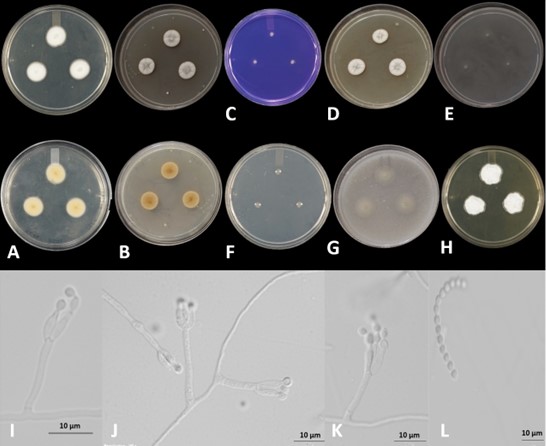Penicillium raperi G. Sm., Trans. Br. Mycol. Soc. 40(4): 486 (1957).
MycoBank number: MB 302421; Index Fungorum number: IF 302421; Facesoffungi number: FoF 11433;
No synonyms
Description
Culture characteristics: Colonies growing after 5 days at 25 ± 2 ºC on following agar media: CYA colonies medium growing, deep radial sulcations, cottony, slightly, umbonate, cottony, velutinous to floccose, mycelium white, 11–12 mm in diam.; margins regular, deep; sporulation pale yellowish-white (2A2); exudate absent; soluble pigment absent; reverse filamentous, mycelia chocolate (brown) (6F4), sporulation white. MEA colonies medium growing, velutinous, slightly umbonate, cottony, (1C4) light grey mycelia, radially sulcate, often raised centrally, velutinous to somewhat floccose, 18–20 mm in diam.; margins regular; sporulation greyish white (6A1); exudates absent; soluble pigments absent; reverse radiate, cream (4A3). CYAS colonies moderate growing, floccose, radially sulcate, slightly suppressed, mycelia pale grey (3B1), white, pale grey (3B1),18−20 mm in diam.; margin regular, deep; sporulation white; exudates absent; soluble pigments absent; reverse wrinkled, mycelia brownish grey (6F8), cream sporulation. OA colonies moderate growing, planar, filiform mycelia, cottony, suppressed, mycelia greyish green (29B4), 18-20 mm in diam.; margin regular; sporulation white; exudates colourless; soluble pigments absent; reverse white greyish brown (6D3), sporulation pale yellow (2A3). CZ colonies slow-growing, flat, granular, radiate, cottony, flat, pale yellowish-white (2A2) mycelia, 9 mm in diam.; margin irregular; sporulation white; exudates absent; soluble pigments absent; reverse pastel yellow (2A4) mycelia, white sporulation. DG18 colonies slow-growing, planar, mycelium white, 4-5 mm diam.; margin regular; exudates absent; soluble pigments absent; reverse white (1A1). YES colonies medium growing, floccose, cottony, umbonate, slightly sulcate, mycelia pale yellow (4A3), sporulation medium grey (4E1), 20–21 mm diam.; margin irregular; exudates absent; soluble pigments absent; reverse wrinkled, mycelia golden (4B6), pastel yellow (3A4), sporulation pale yellow (3A3). CREA colonies 4−5 mm in diam.; margin regular; acid production present. Conidiophores predominantly monoverticillate with occasionally a divaricate branch; stipes smooth-walled, slender and long (200−800 × 2.0−3.0 µm), with vesicular apices up to 3.0−5.0 µm, vesicle bearing 6−10 phialides; phialides ampulliform with a distinct neck, 8.0−11.5 × 3.0−4.0 µm; conidia smooth or finely rough-walled, globose to broadly ellipsoidal 2.5−3.5 × 2.0−3.0.
Material examined: INDIA, Jammu & Kashmir, Kishtwar (33°28′58″N, 75°50′51″E) from soil sample, 20 March 2019, Rajeshkumar K.C., Nikhil Ashtekar (NFCCI 5066).
Distribution: Great Britain
Sequence data from this collection: ITS: OK345044 (ITS5/ITS4); BenA: OL652648 (Bt2a/Bt2b); CaM: OM948805 (CMD5/CMD6); RPB2: OL652654 (fRPB2-5F/fRPB2-7CR)
Notes: In the concatenated phylogenetic analyses of the ITS, BenA, CaM, and RPB2 genes shows that our isolate (NFCCI 5066) clustered with the type stain of P. raperi (NRRL2674=CBS 218.58) having a bootstrap value of 100%. Further, NFCCI 5066 shows similar morphological characters such as predominantly monoverticillate branching with smooth and globose conidia. Hence, we designate our collection (NFCCI 5066) as P. raperi based on the morphological and phylogenetic evidence. This is the first report of P. raperi from India.
Importance of species to humans or ecosystem: There is no record of any threat to humans or ecosystem
Quarantine significance: No data available regarding quarantine. Fungi belonging to BS level I
Biochemical importance, chemical diversity or application: No data available

Fig. 1. Penicillium raperi. A, B Colonies after 5d at 25± 2 ºC on CYA and MEA obverse and reverse. C CREA obverse. D CYAS obverse. E CZA obverse. F DG18 obverse. G OA (natural) obverse. H YES obverse. I-K monoverticillate conidiophore. L Conidia. Scale bar: I-L=10 μm.
